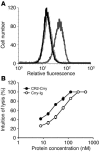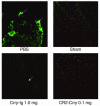Targeted complement inhibition by C3d recognition ameliorates tissue injury without apparent increase in susceptibility to infection
- PMID: 16127466
- PMCID: PMC1190375
- DOI: 10.1172/JCI25208
Targeted complement inhibition by C3d recognition ameliorates tissue injury without apparent increase in susceptibility to infection
Abstract
Previous studies indicate a pivotal role for complement in mediating both local and remote injury following ischemia and reperfusion of the intestine. Here, we report on the use of a mouse model of intestinal ischemia/reperfusion injury to investigate the strategy of targeting complement inhibition to sites of complement activation by linking an iC3b/C3dg-binding fragment of mouse complement receptor 2 (CR2) to a mouse complement-inhibitory protein, Crry. We show that the novel CR2-Crry fusion protein targets sites of local and remote (lung) complement activation following intestinal ischemia and reperfusion injury and that CR2-Crry requires a 10-fold lower dose than its systemic counterpart, Crry-Ig, to provide equivalent protection from both local and remote injury. CR2-Crry has a significantly shorter serum half-life than Crry-Ig and, unlike Crry-Ig, had no significant effect on serum complement activity at minimum effective therapeutic doses. Furthermore, the minimum effective dose of Crry-Ig significantly enhanced susceptibility to infection in a mouse model of acute septic peritonitis, whereas the effect of CR2-Crry on susceptibility to infection was indistinguishable from that of PBS control. Thus, compared with systemic inhibition, CR2-mediated targeting of a complement inhibitor of activation improved bioavailability, significantly enhanced efficacy, and maintained host resistance to infection.
Figures










References
-
- Lazar HL, et al. Soluble complement receptor type I limits damage during revascularization of ischemic myocardium. Ann. Thorac. Surg. 1998;65:973–977. - PubMed
-
- Tsunooka N, et al. Bacterial translocation secondary to small intestinal mucosal ischemia during cardiopulmonary bypass. Measurement by diamine oxidase and peptidoglycan. Eur. J. Cardiothorac. Surg. 2004;25:275–280. - PubMed
-
- Chai PJ, et al. Soluble complement receptor-1 protects heart, lung, and cardiac myofilament function from cardiopulmonary bypass damage. Circulation. 2000;101:541–546. - PubMed
-
- Harkin DW, Romaschin A, Taylor SM, Rubin BB, Lindsay TF. Complement C5a receptor antagonist attenuates multiple organ injury in a model of ruptured abdominal aortic aneurysm. J. Vasc. Surg. 2004;39:196–206. - PubMed
-
- Andersson B, Nilsson J, Brandt J, Hoglund P, Andersson R. Gastrointestinal complications after cardiac surgery. Br. J. Surg. 2005;92:326–333. - PubMed
Publication types
MeSH terms
Substances
Grants and funding
LinkOut - more resources
Full Text Sources
Other Literature Sources
Medical

